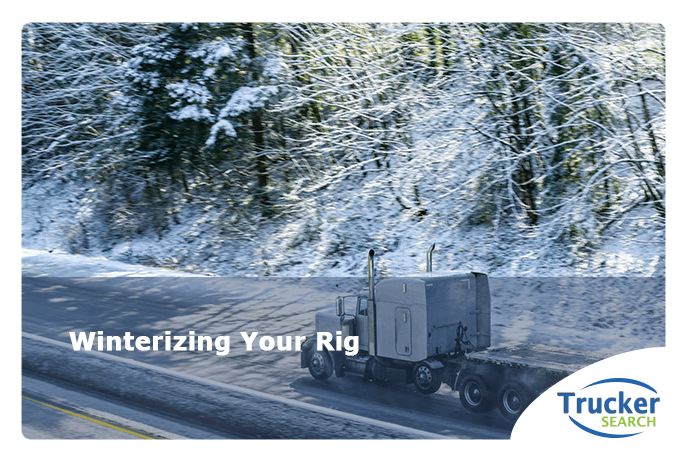Winterizing Your Rig
With cooler temperatures and winter weather upon us, it is important to take action to ensure your truck is ready for winter weather conditions, keeping your costs down, and staying safe. The following guidelines will help you do just that. It is extremely important to take action now to make sure your truck is ready for winter weather conditions, keeping your costs down, and staying safe. The following guidelines will help you do just that.
Prepare an Emergency Kit
There is a higher chance of getting stranded during the winter months. Be sure and have the right kind of survival supplies in your truck. These items include:
- Extra blankets
- First aid kit
- Flashlight and extra batteries
- Bottled water
- Canned food
- Gloves, scarves, and hats
- Snow boots
- Snow shovel
- Flares
- Radio
- Extra coolant, washer fluid, and engine oil
- Extra fuel filter and fuel filter wrench
- Tire chains
Check the Batteries
It is important to keep in mind that freezing temperatures drain battery life fast. If any of your batteries are near the end of their life cycle, you should consider replacing them. If it is not, make sure they are firmly mounted and all of the connections are tight and clean. Performing a load test on each battery will help you determine if you have one going bad.
Check the Fuel Filter and Water Separator
Because there is no way to easily check the contamination level of a fuel filter consider proactively changing your fuel filter as cold weather sets in.. Keep an eye on the water separator daily to decrease any chances of it becoming completely full of water and starving your engine of fuel. Water is a well-known pollutant in diesel fuel especially in the winter due to condensation in fuel tanks. If you notice a large amount of water has been collected, make sure you drain it. Since many separators are not self-cleaning, you will have to find the separator, which is normally near the fuel filter, and turn the drain valve in order to get rid of the water.
Use Fuel Additives
Paraffin, a wax, is found in diesel fuel and crystallizes when the temperature is below freezing. Crystallization of the wax causes the fuel to become slushy and gel-like. When this happens, the fuel is unable to pass through the fuel filter. When the fuel becomes gelled, your engine will be starved for fuel and the engine will stall. Adding an anti-gel fuel additive or fueling with winterized fuel can prevent this from happening. Make sure you check your owner’s manual for exact additive guidelines and follow mixing directions precisely. If you don’t, you risk damaging your fuel system.
Inspect the Cooling System
Do a complete inspection of the entire cooling system including the radiator, checking the hoses for any bulges, and inspecting hose clamps to make sure they are secure and not damaged. It is also a good idea to have your coolant tested to make sure it is at an ideal freeze point. Make sure you use the right coolant for your truck
Keep the Engine Warm
Diesel fuel is less combustible at low temperatures making your truck harder to start. If you live someplace cold or know you will be traveling to a place with cold temperatures, installing an electric block heater would be a good idea. This will keep the engine warm while it is shut off. Be sure the block heater is plugged into a receptacle capable of handling the load.
Check the Air Dryer
The air dryer collects and removes water before it enters the brake system, which stops it from freezing in the brake lines. Inspecting the air dryer will help you determine whether or not it is functioning correctly. It is important to replace the filter if necessary and to drain the air reservoirs every so often. If you do not maintain the air dryer, you’re taking the chance of causing your brakes to malfunction.
Prepare the Windshield
Snow and ice on the windshield makes it hard to drive and can be dangerous. Check to make sure your windshield wipers are in good working condition, and if not, replace them. Also make sure your windshield wiper fluid is full and you are using a cold temperature blend.
Check Your Tires
In order for you to navigate safely through snow and ice, your tires need to be in good shape. Thoroughly check your tires to make sure they are fully inflated, if you are traveling through states that require tire chains, and be sure you have the right size and number of chains in your truck. Make sure you check the chains to see if they are worn, twisted, or damaged links, and if they are, replace them.
Know what you can and cannot do when it comes to maintenance. Although self-maintenance can be cost-effective, it can also become expensive and dangerous if you are not a professional mechanic. Allow a professional to help you with what you are unable to do yourself, so your truck can be winterized and you can feel safe this winter season.

